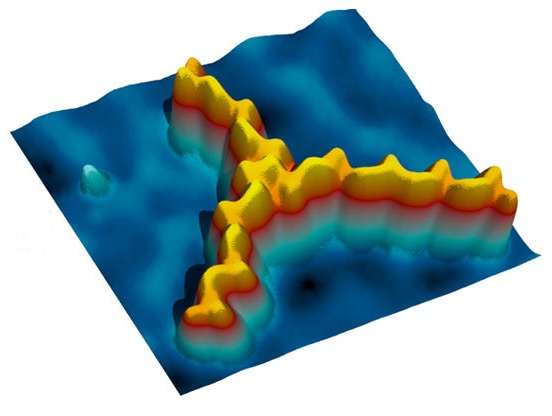February 3, 2016 feature
Tiniest spin devices becoming more stable

(Phys.org)—In 2011, the research group of Roland Wiesendanger, Physics Professor at the University of Hamburg in Germany, fabricated a spin-based logic device using the spins of single atoms, a feat that represents the ultimate limits of miniaturization. In these tiny devices, all of the atoms must be precisely positioned so that their spin information can be transmitted from one atom to the next.
The problem is that the atoms don't want to stay in their designated positions for very long. Even the tiniest amount of heat can overcome the weak magnetic coupling between an atom and substrate that helps keep the atom in place. As a result, the spin-based logic device only works at temperatures below 0.3 K, barely above absolute zero.
Now in a new paper published in Nano Letters, Wiesendanger's team has demonstrated spin-based logic devices that are made of molecules instead of atoms. The molecules are held in place by superexchange magnetic coupling, which is much stronger than weak magnetic coupling. The stronger interactions translate to an order of magnitude higher operation temperature, up to 6 K. The molecular spin devices, which are almost as small as the atomic version, have much higher stability and they still offer the same potential advantages of high-speed operation and low-power consumption that make spintronics devices so attractive.
"We now have all the building pieces on the surface to create devices out of molecular building blocks," lead author Maciej Bazarnik, a physicist at the University of Hamburg and at the Poznan University of Technology in Poland, told Phys.org.
In general, spin-based devices work by controlling the spins of electrons, just as conventional electronics devices control electron charge. Similar to how charge is considered to be either negative or positive, spin is regarded as being either up or down. By applying a magnetic field, researchers can generate an excess of spin up or spin down electrons, creating a net spin polarization and producing a magnetic spin current.
To build an all-spin logic device, the challenge is that the atoms and molecules must be arranged so that they act as wires, junctions, and other building blocks for transmitting the easily disturbed spin information from one place to another.
In the new study, the researchers built these components out of coordination compounds, which are magnetic molecules that consist of a central metal atom (here, cobalt) linked to surrounding groups of atoms. These groups are carefully chosen to achieve strong magnetic interactions between the spin-carrying metal atoms of adjacent compounds, allowing the spin information to be transferred.
The researchers also engineered the chemical structure to alleviate another problem facing atomic-scale spin devices: by transporting the spin information more directly between junctions, they could greatly reduce unwanted interference with neighboring devices.
With their greater stability, the molecular spin logic devices represent a step toward making very small spin devices at higher temperatures, which is necessary for realizing future applications.
"We are exploring different magnetic centers in our molecules to achieve stronger magnetic couplings and raise the operating temperature even higher," Bazarnik said. "Since all-spin devices are ultimately small, using them in future nanoelectronics would be beneficial. They operate on a spin degree of freedom and therefore no flow of [electric] current is necessary for the information to be transmitted. Hence there is no heating and very low power consumption."
More information: Maciej Bazarnik, et al. "Toward Tailored All-Spin Molecular Devices." Nano Letters. DOI: 10.1021/acs.nanolett.5b04266
Journal information: Nano Letters
© 2016 Phys.org




















